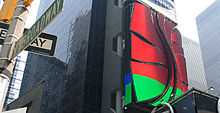Coca-Cola sign

The Coca-Cola Sign is an electro-kinetic sculpture created in 2004 as part of the centennial celebrations of the square, replacing the famous three-dimensional bottle design that stood for years in the center of Times Square, located in Manhattan, New York.[1]
Built by digital LED display manufacturer Daktronics and titled "Simply Coke," the sign is covered in programmable Light-emitting diodes and allows an array of graphics to be displayed.
Design and inspiration
The multi-layered billboard has a highly complex pattern of stainless steel planes and exposed superstructure. The sign's design is inspired by Manhattan's steel and glass monoliths and the frenetic pace of midtown street traffic. The 3-D composition renders the Dynamic Ribbon Device in both positive form and negative space. The display also offers the possibility of live video streaming across the sign's curvature.
The sign attains 180-degree visibility by sculpting LED panels around the 8' horizontal thrust. According to Wright Massey, owner of Brand Architecture Inc. and creator of the sign, "We realized that a vibrant, simple design would draw focus in the frenzied pandemonium of Times Square. Drawing from recent Coca-Cola marketing research, we found the Dynamic Ribbon Device the best vehicle for conveying key brand values. We wanted a contemporary, authentic statement, full of energy, optimism, and youthful spirit. We wanted our sculpture to inspire consumers on all three emotional levels: head, heart and gut."
During the unveiling ceremony on July 1, 2004, which was also in the middle of an advertising campaign for Coca Cola C2, the sign shown "The Time Machine", a tribute to the past of Coca Cola and New York City, soon after activation.[1][2]
Behind the design
The video programming displays a series of graphic images that are meant to connect to Coca-Cola consumers on a rational "head" level. Images communicate product names, info relating to seasonal promotions, and corporate logos in a many different languages for the global visitors of Times Square.
The sign also displays a series of graphic images that are meant to connect to Coca-Cola consumers on a "heart" level. Images are generated to elicit certain moods and feelings from Coca-Cola consumers, relating to the conditions in the Square at different times of day and night, and across the changing seasons.
The Coca-Cola Company and MoMA (The Museum of Modern Art) selected Brand Architecture's distinctive design from an assemblage of fifteen design firms from across the United States.
Once the design was selected, Coca-Cola chose Daktronics and its staff of engineers to translate Brand Architecture's concept from a small-scale model into a 30-ton, six-story high, fully functioning LED video display. The display measures approximately 44 feet by 65 feet and includes more than 2.6 million LEDs with 16.5 mm and 23 mm center-to-center pixel pitches.
Gallery
-

The original Coke Sign, circa 1997
-

At the unveiling of the Coke sign in 2004, silhouettes of construction workers add the final touches
-

Early conceptual design of the sign by Brand Architecture Inc., 2004
References
- ↑ 1.0 1.1 http://www.coca-colacompany.com/stories/coke-lore-times-square Coke Lore- Coca-Cola Unveils a New Sign in Times Square
- ↑ In Times Square, Coke Puts On a Flashier Face; In the Age of Infinite Ads, Only an 882,112-Pixel Supersign Will Do
See also
| |||||||||||||||||